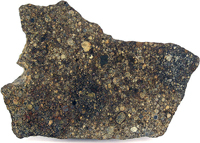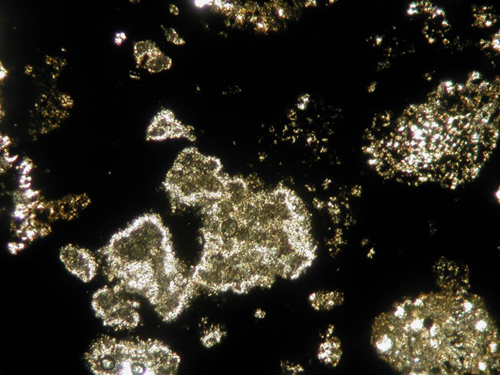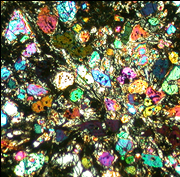Extraterrestrial Rocks

Enlargement
Slice of the meteorite NWA 3119. Many small spherical chondrules are visible in this LL4 ordinary chondrite. |
Stony meteorites are mainly composed of two silicates: olivine and pyroxene. Unlike terrestrial rocks, they contain iron-nickel minerals. There are two types of stony meteorites: chondrites and achondrites. Chondrites contain chondrules, which are small silicated spheres, and their heavy element composition is similar to that of the Sun. They formed at the same time as the solar system. Achondrites do not contain chondrules; their original composition has been destroyed. They come from the crust of parent bodies that differentiated. The denser metal sank toward the centre of the parent body while the rock concentrated at the surface.

Enlargement
This whitish, irregularly shaped mass is a calcium aluminum inclusion. This type of inclusion is found in carbonaceous chondrites. |
There are three types of chondrites: ordinary, carbonaceous, and enstatite. Ordinary chondrites are given a letter that indicates their total metal content. H-chondrites contain between 25 and 30% iron, L-chondrites contain a little less iron (between 20 and 23%), and LL-chondrites contain even less (between 19 and 22%). Along with the letter is a number related to the alteration of the chondrules, which may be abundant and very distinct, or sparse and indistinct.
Carbonaceous chondrites contain a relatively large proportion of carbon, which gives them a dark grey colour. They can be identified by the presence of large, irregularly shaped, white inclusions. Enstatite chondrites are essentially composed of the mineral from which they get their name.
 |
| Enlargement |
| Photomicrograph of a chondrule from the Allende meteorite. |
|